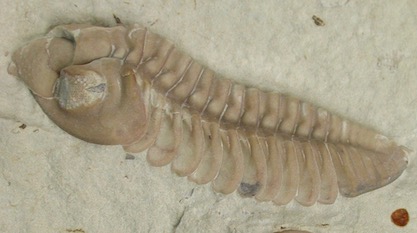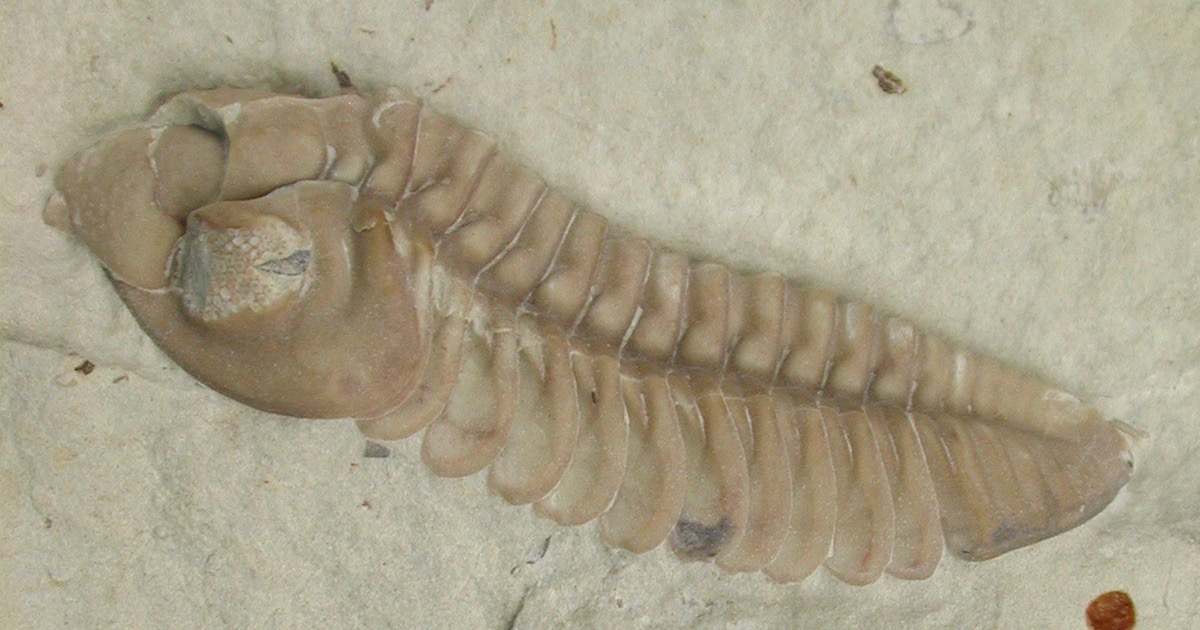 Evolution
Evolution
 Intelligent Design
Intelligent Design
Alleged Refutation of the Cambrian Explosion Confirms Abruptness, Vindicates Meyer


The top-down pattern of appearance of animal phyla during the Cambrian explosion represents major conflicting evidence for Darwinian evolution. Since this is so, there have been numerous attempts in the past to explain away the inconvenient truth and fudge the facts to fit the theory, rather than try to find the best explanation for the pattern of evidence in nature.
Such futile attempts include the claim that the Cambrian explosion was a much longer event, that the sudden appearance is just an artifact of Linnaean classification while cladistic classification makes the problem disappear, that Ediacaran organisms such as Kimberella and Spriggina or Ediacaran trace fossils and small shelly fossils represent putative ancestors of the Cambrian phyla. And of course there is the usual appeal to the incompleteness of the fossil record (aka the artifact hypothesis). All these dubious claims, including those made by staunch ID-critics like Nick Matzke, P.Z. Myers, and Donald Prothero, rather than by actual specialists on Cambrian fossils, have all been addressed and refuted before (e.g., see Meyer 2013, Klinghoffer 2015, and Bechly 2018).
New Paper from Allison C. Daley
Now, a new paper by Daley et al. (2018), with an accompanying press release from the University of Oxford (2018), is said to challenge the abruptness of the Cambrian explosion. The paper allegedly settles the case in favor of a more gradual pattern of appearance as predicted by Darwin’s theory. That would be big news indeed, if it were true. Darwinists bloggers are thrilled
To judge from the hype, you might expect that the authors of the new paper have discovered a well-dated temporal transitional series of fossils, documenting a gradual evolution stretched out over a long period of time, rather than an explosive event. Well, far from that. Actually, the article presents no new fossil evidence, no new phylogenetic studies, nor any new scientific results at all. Instead, it is just a review of other recent work. This is why it was published in the “Perspectives” section of the journal PNAS.
The press release announces, “[N]ew research from the University of Oxford in collaboration with the University of Lausanne suggests that for most animals this ‘explosion’ was in fact a more gradual process.” This is already a highly misleading statement, as the paper only deals with euarthropods and not any other group of animals. At most it could prove a more gradual origin of euarthropods, thus of a single lineage within a single one of the 28 animal phyla. But does it even achieve this limited goal? They continue with the claim, “A team based at Oxford University Museum of Natural History and the University of Lausanne carried out the most comprehensive analysis ever made of early fossil euarthropods from every different possible type of fossil preservation.” This is factually incorrect. What the new study achieves is nothing new at all: based on other cladistic studies, they ordered the fossils according to their inferred sequence of branching from the euarthropod stem line, irrespective of their temporal ordering, and thereby identify a supposed order of character acquisition.
This has been done before multiple times by other studies on early arthropod phylogeny by eminent paleontologists like Graham Budd, Gregory Edgecombe, and David Legg. The alleged new result is not evidence at all, but rather high level interpretation of evidence based on several unquestioned background assumptions such as universal common ancestry and the principle of parsimony. It is by no means the “most comprehensive analysis” of its kind (e.g., compared to Legg et al. 2013, who studied 309 panarthropod taxa and 753 morphological characters). The authors also fail to discuss any incongruent evidence, such as the strange fact that lobopodians like Hallucigenia, which are believed to be more basal stem arthropods, do have legs, while radiodonts like Anomalocaris, which are believed to be more advanced stem arthropods, lack any postcephalic legs.
A Welcome Confirmation
Claims from the Darwinist peanut gallery notwithstanding, nothing genuinely new is to be found in the paper. Nevertheless, this publication is still very interesting for other reasons.
Instead of refuting the abruptness of the Cambrian explosion, Daley et al. (2018) confirm that the fossil record of euarthropods is even more abrupt than often believed. How so? Because the oldest body fossils from crown group arthropods like trilobites indeed predate (!) their alleged ancestors by about three million years. The authors recognize that this is a problem. They admit, “It may seem counter-intuitive that crown group euarthropods appear at 521 Ma, while the first appearance of stem lineage euarthropods is not until 518 Ma.” To solve this temporal paradox the authors have to postulate a ghost lineage of stem euarthropods that predate the oldest fossil trilobites but left no record of body fossils. Such hypothetical ghost lineages are required by the unquestioned assumption of universal common descent. Surprisingly, they also appeal to the artifact hypothesis (“… stem lineage euarthropods lack biomineralized exoskeletons and require preservation of soft tissues …”) even though they themselves show in their work that the Burgess-Shale-type (BST) conditions for soft tissue preservation existed all the way down to the Ediacaran period.
Trying to evaluate the length of the ghost lineage, the authors write: “However, stem lineage euarthropods would have evolved before trilobites, even if they are not preserved, so the real question is how much earlier than 521 Ma did they appear? The answer comes from the trace fossil record.” The problem is that according to the writers, the oldest unequivocal arthropod trace fossils are again made by euarthropod trilobites (537-million-year-old Rusophycus traces) and thus not by stem euarthropods. They admit, “In contrast, Rusophycus … provides definitive evidence of crown group Euarthropoda … This makes Rusophycus the oldest euarthropod trace globally … During the Ediacaran period, euarthropod trace fossils are ‘strikingly absent.’” Consequently, the trace fossil record documents an even earlier presence of euarthropods, long before the morphologically more primitive lobopodian and radiodont fossils, implying even longer ghost lineages for stem euarthropods that conflict with the actual fossil record.
Triple Vindication for Meyer
There is more. Even though Daley et al. (2018) do not bother to mention Darwin’s Doubt, they vindicate three main theses of Stephen Meyer’s book.
First, the authors confirm Stephen Meyer’s refutation of the artifact hypothesis and my own argument from the absence of animals in recently discovered Burgess-Shale-type fossil localities from the Ediacaran period (Bechly 2018). As they clearly affirm in the Abstract
A deep Precambrian root to the euarthropod evolutionary lineage is disproven by a comparison of Ediacaran and Cambrian lagerstätten. BSTs from the latest Ediacaran Period (e.g., Miaohe biota, 550 Ma) are abundantly fossiliferous with algae but completely lack animals, which are also missing from other Ediacaran windows, such as phosphate deposits (e.g., Doushantuo, 560 Ma).
In the article they elaborate:
Modes of Fossil Preservation Are Comparable in the Cambrian and Precambrian … Hypotheses that regard Precambrian preservation as insufficient to preserve euarthropods can no longer be sustained, given the abundant lagerstätten from the Ediacaran Period. Similarly, claims that euarthropods evolved as a tiny and soft-bodied meiofauna that escaped preservation cannot be substantiated because of how commonly the phosphate window is found in the Ediacaran and lower Cambrian, with microscopic euarthropods not appearing until 514 Ma.
The news item from the University of Oxford makes the point even more clearly:
“The idea that arthropods are missing from the Precambrian fossil record because of biases in how fossils are preserved can now be rejected,” says Dr. Greg Edgecombe FRS from the Natural History Museum, London, who was not involved in the study. “The authors make a very compelling case that the late Precambrian and Cambrian are in fact very similar in terms of how fossils preserve. There is really just one plausible explanation — arthropods hadn’t yet evolved.”
Second, the authors mention that “Spriggina, for example, does not possess bilateral symmetry, but instead has a marked offset along the midline, and this alone is sufficient to reject a euarthropod affinity … No euarthropod claim from the Ediacaran biota can therefore be substantiated.” Thus, Daley et al. clearly reject any arthropod affinity of Ediacaran organisms such as Spriggina, also because of their non-bilaterian glide symmetry. Guess who made exactly this point before? Yes, it was Stephen Meyer (2013) in Darwin’s Doubt.
A Very Acute Waiting Time Problem
Finally, the paper by Daley et al. confirms that the Cambrian explosion implies a very acute waiting time problem, again as elaborated by Meyer (2013). Based on their postulated ghost lineages and on molecular clock data, the authors suggest that euarthropods originated about 541 million years ago. They conclude, “Rather than being a sudden event, this diversification unfolded gradually over the ∼40 million years of the lower to middle Cambrian, with no evidence of a deep Precambrian history.” However, this conclusion is totally speculative and an artifact of their methodological assumptions. It is not based on actual fossil evidence (see above). The latter indeed suggests that the euarthropod body plan appeared with trilobites in the Lower Cambrian, as if out of thin air without any known precursors and without any fossil evidence for a gradual step-wise generation of this body plan.
Far from being a refutation of the abruptness of the Cambrian explosion, this study actually confirms it and makes the abruptness of the event even more acute. Here is why: since the authors refute the existence of stem group arthropods in the Ediacaran period before 550 million years, and euarthropods are documented already for the Lower Cambrian at 537 million years, there remains a window of time of only 13 million years to evolve the stem arthropod body plan from unknown ecdysozoan worm-like ancestors and to make the transition from lobododian pro-arthropods to the fully developed euarthropod body plan, with exoskeleton, articulated legs, compound eyes, etc. Since the average longevity of a single marine invertebrate species is about 5-10 million years (Levinton 2001: 384, table 7.2), this available window of time equals only about two successive species. Considering the implied enormous re-engineering involved, this time is much too short to accommodate the waiting times for the necessary genetic changes to occur and spread according to the laws of population genetics.
Literature:
- Bechly G 2018. “A Paleontologist on Why the ‘Cambrian Explosion’ Label Persists.” ID the Future April 23, 2018.
- Daley AC, Antcliffe JB, Drage HB, Pates S 2018. “Early fossil record of Euarthropoda and the Cambrian Explosion.” PNAS, 9 pp.
- Klinghoffer D 2015. Debating Darwin’s Doubt: A Scientific Controversy That Can No Longer Be Denied. Discovery Institute Press, 350 pp.
- Legg DA, Sutton MD, Edgecombe GD 2013. “Arthropod fossil data increase congruence of morphological and molecular phylogenies.” Nature Communications 4, 2485.
- Levinton JS 2001. Genetics, Paleontology, and Macroevolution. Cambridge University Press, 617 pp. (Google Books).
- Meyer SC 2013. Darwin’s Doubt: The Explosive Origin of Animal Life and the Case for Intelligent Design. HarperOne, 512 pp.
- University of Oxford 2018. “Major fossil study sheds new light on emergence of early animal life 540 million years ago.” EurekAlert! 21-May-2018; Phys.org May 21, 2018.
Photo: Kainops invius, by Moussa Direct Ltd. (Moussa Direct Ltd. image archive) [CC BY-SA 3.0], via Wikimedia Commons.
